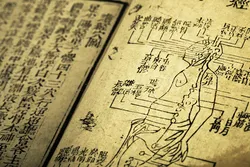
Chinese and Vietnamese ethnicity indicates genetic origins in China and Vietnam. Stretching over 9,500,000 square kilometers, and encompassing a rich variety of ecological zones — ranging from tropical in the south to subarctic in the north — China is among the four largest countries in the world. Its geographical diversity is reflected in its demography, as China is home to over fifty distinct ethnic groups. Yet, despite the country’s ethnic diversity, of the 1.4 billion people making up the Chinese population, 1.2 billion (over 90% of the population) belong to the Han people. Extended periods of Chinese domination have extended the Han sphere of influence into regions of Southeast Asia. Thus, while the area that extends from China to include Vietnam is home to thousands of distinct ethnic subgroups, they share a strong genetic link with the inhabitants of China. Today, due largely to large waves of immigration in the nineteenth century, tens of millions of ethnic Chinese people are dispersed across Asia, Europe, the Americas, Oceania, and Africa.
Research your ancestors on MyHeritage
Chinese and Vietnamese historyChinese and Vietnamese history
Chinese civilization began along the Yellow River in the Shang era (tenth-sixteenth century B.C.E.), spreading from there into the North China Plain. During the subsequent Zhou era (third-tenth century B.C.E.), Confucianism and Daoism — the major philosophies and religions of China — emerged. In the third century B.C.E., Ying Zheng, the king of Qin, unified the six other major Chinese states of the time and proclaimed himself the First Emperor. Qin Shi Huang’s iron rule was short-lived, but in his wake, imperial dynasties would rule China for over two thousand years. Adopting Confucianism and an elaborate bureaucratic system, the Han dynasty ruled China and large parts of Vietnam for nearly four hundred and fifty years. The Han’s decline ushered in an era of great disunity (during which time Buddhism arrived and took root in northern China) which lasted nearly four hundred years until the Sui dynasty finally unified China again in 581 C.E.

The following centuries saw China become among the most culturally sophisticated and technologically advanced polities in the world. The Sui dynasty (581–618) constructed the Great Canal and rebuilt and expanded the Great Wall of China; the Tang era (618–907) is considered the golden age of Chinese poetry, painting, and crafts, such as glazed pottery and woodblock painting; the Song era (960–1297) is known for advances in civil engineering, shipbuilding and navigation, and metallurgy, as well as for significant elaborations on the “Four Great Inventions” of ancient China: papermaking, printing, the compass, and gunpowder.
In 938, a leader named Ngo Quyen defeated the Song at the battle of Bach Dang River and established an independent state in North Vietnam. In the late thirteenth century, Genghis Khan’s grandson, Kublai Khan, conquered the Song and founded the Yuan dynasty, ushering in an era of unprecedented trans-Eurasian connectivity, which saw a veritable explosion of cross-continental cultural and technological dissemination. The Mongols invaded Vietnam on three occasions, but each time they quickly withdrew. Vietnam maintained its independence for nearly a millennium until it came under French colonial rule in the nineteenth century.
By the fourteenth century, Mongol rule in China was on the wane. The Ming dynasty managed to overthrow the declining Mongols and establish what would become the last Han Chinese dynasty, ruling until the mid-seventeenth century. Under the Great Ming, the Forbidden City was constructed, and Beijing became the seat of the empire. Starting in the late eighteenth century, internal revolts, population growth, economic disruption, corruption, and external pressures by European maritime empires precipitated the Great Qing’s decline. The Xinhai Revolution of 1911 led to the abdication of the last Qing emperor and the establishment of the Republic of China.

In 1929, a civil war broke out between government forces and the Communist Party of China. The Japanese invasion of China during the Second World War led to a break in hostilities, but in the late 1940s, the communists under the leadership of Mao Tse Tung finally subdued government forces and established the communist People’s Republic of China. To the west, having thrown off the French yoke, North Vietnam came under the communist rule of Ho Chi Minh. Following a protracted and bloody war against the United States, Vietnam was united under the banner of the communist north. A series of market reforms in the late 1980s opened Vietnam to the west.
In China, Mao Tse Tung established a brutal authoritarian regime. Mao’s economic and social reforms — the “Great Leap Forward” and the “Cultural Revolution” — ushered in a dark period in Chinese history, in which tens of millions of Chinese lost their lives. A “Reform and Opening Up” policy established in 1978 brought about phenomenal economic growth. Today, China’s remarkable economic resurgence has cemented the country’s place as one of the world’s great superpowers.
Chinese cultureChinese culture

Chinese religion, philosophy, and political thought — stemming from Confucianism, Daoism, and Buddhism — have left a lasting impression on Chinese culture and tradition. Concepts of energetic and physical symmetry, such as the yin and yang (the Taoist dualist formula of balance between opposing but complementary forces) and feng shui (the harmonizing of spiritual forces through the positioning of objects in space) underscore traditional currents within Chinese art forms, such as architecture, poetry, and painting. Elements of Chinese folklore, such as the Chinese dragon — a powerful, auspicious, and benevolent symbol in Chinese culture — are a long-standing feature of East Asian decorative arts. Traditional Chinese medicine, including various forms of herbal medicine, acupuncture, cupping therapy, massage therapy, and more, has recently enjoyed a resurgence of popularity in Western societies.
The geographical varieties and plethora of ethnic groups in China has bred a great diversity of local cultures. Chinese cuisine reflects this diversity, as each region has its own culinary specialties, such as Cantonese cuisine — which features an array of stir-fried dishes — and Szechuan cuisine, known for its spiciness and emphasis on the use of peanuts, sesame paste, and ginger. Not only has Chinese food heavily influenced cuisine in other parts of Asia, its main food staples — namely rice, soy sauce, and noodles — have become mainstays in kitchens and restaurants across the world.
Vietnamese cultureVietnamese culture
Vietnamese culture is one of the oldest in Southeast Asia. Vietnamese cuisine, commonly classified into three categories pertaining to the north, south, and central regions of the country, boasts a rich variety of noodle soups (such as the popular phở - a soup consisting of broth, rice noodles, herbs, and meat), rice dishes, salads, curries, and unique dishes such as bánh (a wide variety of sweet or savory buns and pastries which are either cooked, steamed, baked, fried, or boiled). Vietnam celebrates several annual festivals, including both traditional events and those adopted from other cultures. Most notable are Tết Trung Thu (the mid-autumn lantern festival), Lễ Phật Đản (Buddha's birthday), and Tết (the lunar new year), all celebrated with great pomp and splendor.
Chinese and Vietnamese languagesChinese and Vietnamese languages

China has a highly diverse linguistic landscape. Linguists believe that there are nearly three hundred living languages in China today, which form the Sinitic branch of the Sino-Tibetan languages. The most common of them is Modern Standard Mandarin, a tonal language spoken by 920 million people in China. Though its vocabulary is infused with Chinese loan words, Vietnamese belongs to the Austroasiatic (East Asian) language family. It is spoken natively by approximately 80 million people.
See moreSee more
Explore more about ethnicity estimatesExplore more about ethnicity estimates
- MyHeritage DNA
- Ethnicities around the world at MyHeritage
- What Is My Ethnicity? How MyHeritage Estimates Ethnicities at MyHeritage Knowledge Base
- Where's My Ethnicity?!: Why An Ethnicity Might Not Show Up In Your DNA (and How To Find Evidence Of It Anyway) at MyHeritage Knowledge Base

